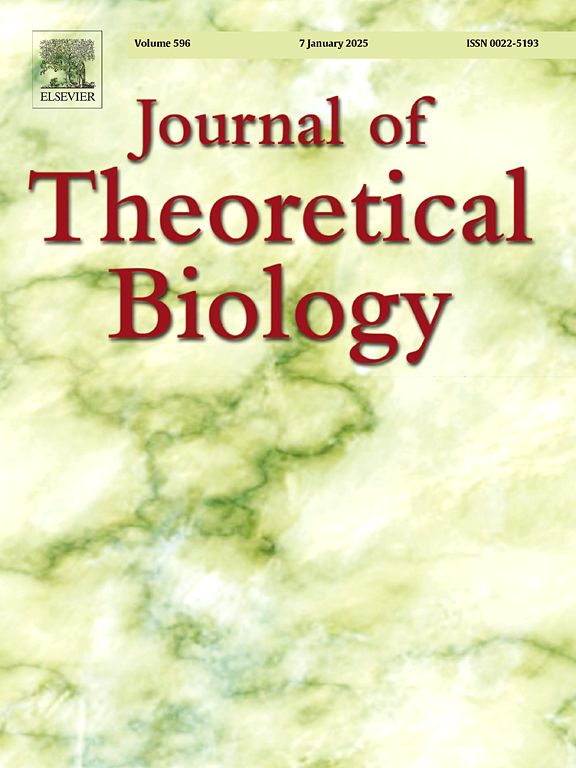在基于血流动力学的直径适应下动脉拱廊和侧枝的退化:一个计算和数学分析。
IF 1.9
4区 数学
Q2 BIOLOGY
引用次数: 0
摘要
动脉网络表现出广泛的区段半径,主要被认为是由于适应壁面剪切应力(WSS)。如果WSS高于或低于参考值,片段将向外或向内重构。虽然这种机制对于主干树来说似乎很简单,但真实的网络包含拱廊、支线和循环。我们利用小网络的模拟模型和发表的冠状动脉和大脑动脉数据,研究了这些环结构在WSS控制下的稳定性。自适应建模为段半径的变化与参考WSS的偏差成正比。广义模型包括其他血流动力学刺激,如流量和速度。无论初始条件或模型参数如何,对于WSS模型和广义模型,由于一个或多个片段的损失,模拟一致地预测了环路回归。在具有异质适应速率或动态条件下的网络中也观察到这种环路损耗。数学分析证实,回路不稳定性是基尔霍夫电路定律的直接结果,导致不稳定的平衡。因此,环路的丢失是动脉网络适应局部血流动力学的固有结果。可能需要其他机制,例如连接段之间的通信,来解释实际网络中环路的存在。本文章由计算机程序翻译,如有差异,请以英文原文为准。
Arterial arcades and collaterals regress under hemodynamics-based diameter adaptation: A computational and mathematical analysis
Arterial networks exhibit a wide range of segment radii, largely thought to result from adaptation to wall shear stress (WSS). Segments remodel outward or inward if WSS is higher or lower than a reference value. While this mechanism seems straightforward for arterial trees, real networks contain arcades, collaterals, and loops. We investigated the stability of these looping structures under WSS control using simulation models of small networks and published coronary and cerebral artery data.
Adaptation was modeled as changes in segment radius proportional to deviations from reference WSS. A generalized model included other hemodynamic stimuli like flow and velocity. Simulations consistently predicted loop regression due to the loss of one or more segments, both for the WSS model and the generalized model, regardless of initial conditions or model parameters. This loop loss was also observed in networks with heterogeneous adaptation rates or under dynamic conditions.
A mathematical analysis confirmed that loop instability is a direct consequence of Kirchhoff’s circuit law, leading to unstable equilibria. Thus, loss of loops is an inherent outcome of arterial networks adapting to local hemodynamics. Additional mechanisms, such as communication between connected segments, may be needed to explain the presence of loops in real networks.
求助全文
通过发布文献求助,成功后即可免费获取论文全文。
去求助
来源期刊
CiteScore
4.20
自引率
5.00%
发文量
218
审稿时长
51 days
期刊介绍:
The Journal of Theoretical Biology is the leading forum for theoretical perspectives that give insight into biological processes. It covers a very wide range of topics and is of interest to biologists in many areas of research, including:
• Brain and Neuroscience
• Cancer Growth and Treatment
• Cell Biology
• Developmental Biology
• Ecology
• Evolution
• Immunology,
• Infectious and non-infectious Diseases,
• Mathematical, Computational, Biophysical and Statistical Modeling
• Microbiology, Molecular Biology, and Biochemistry
• Networks and Complex Systems
• Physiology
• Pharmacodynamics
• Animal Behavior and Game Theory
Acceptable papers are those that bear significant importance on the biology per se being presented, and not on the mathematical analysis. Papers that include some data or experimental material bearing on theory will be considered, including those that contain comparative study, statistical data analysis, mathematical proof, computer simulations, experiments, field observations, or even philosophical arguments, which are all methods to support or reject theoretical ideas. However, there should be a concerted effort to make papers intelligible to biologists in the chosen field.

 求助内容:
求助内容: 应助结果提醒方式:
应助结果提醒方式:


